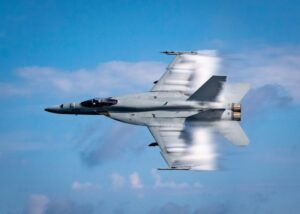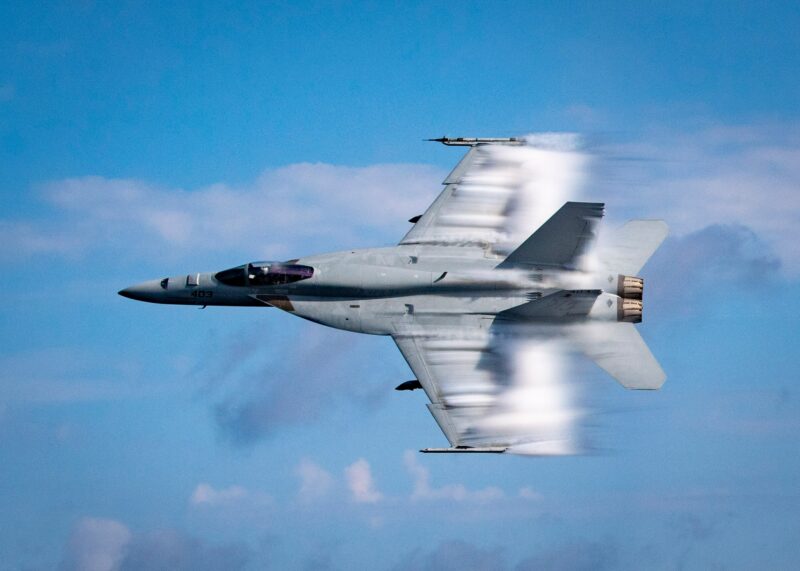
190823-N-UB406-0107
ATLANTIC OCEAN (Aug. 23, 2019) Lt. Cmdr. Benjamin Orloff, assigned to the Blue Blasters of Strike Fighter Squadron (VFA) 34, conducts a supersonic pass in a F/A-18E Super Hornet next to the guided-missile destroyer USS Gridley (DDG 101) during a training exercise. Gridley is underway on a regularly-scheduled deployment as the flagship of Standing NATO Maritime Group 1 to conduct maritime operations and provide a continuous maritime capability for NATO in the northern Atlantic. (U.S. Nav
Did you hear something around noon today? An aircraft out of NAS Patuxent River was identified as going supersonic above 30,000 feet at the time of the loud boom heard on Thursday, December 29, 2022.
NAS Pax River Air Operations confirmed that the flight was authorized.
NAS PAX flight test squadrons conduct several types of supersonic operations in military restricted airspace over the Chesapeake Bay. The aircraft must stay close to shore so that tracking stations along the Bay Shore can record the operation through high-powered cameras.
Although most sonic booms generated in this area are never felt or heard on land, due to weather conditions or the details of the flight, occasionally a sonic boom will be felt or heard on land.
More information about supersonic flight testing at Pax can be read below.
What is a Sonic Boom? A sonic boom sounds like a sharp crack of thunder. It occurs when an aircraft moves faster than its own sound
waves, also known as pressure waves.
Why does NAS Patuxent River conduct supersonic operations? Naval Air Station (NAS) Patuxent River (PAX) is the U.S. Navy’s headquarters for the research, development, test and evaluation of all Navy aircraft, aircraft components and related systems needed to carry out their military mission. Among the tests occurring at NAS PAX are evaluations of jets’ abilities to fly at the speed of sound or “supersonic.”
Why are supersonic flights flown over the Chesapeake Bay? NAS PAX flight test squadrons conduct several types of supersonic operations in military restricted airspace over the Chesapeake Bay. Jet aircraft pilots perform lowlevel weapons separation test flights to ensure that ordnance separates safely from the aircraft when released at supersonic speeds. The aircraft must stay close to shore so that tracking stations along the Bay Shore can record the operation through high-powered cameras. Supersonic flights are also conducted at or above 30,000 feet over the Chesapeake Bay for mission essential flight testing.
Why are supersonic flights flown offshore along the Atlantic coastline? The Department of Defense manages a strip of airspace
used for military testing that begins approximately three miles offshore, over the Atlantic Ocean. This airspace, called the “Test Track,” is designated for the performance of specific flight tests, including those that require supersonic speeds. Military aircraft from NAS PAX and neighboring military installations visit the Test Track to fly supersonic on a routine basis. The area is located offshore, as to avoid overflight of populated land areas, but close enough for the safety of the aircraft and pilots, and to conserve on jet fuel to and from the test area. Although most sonic booms generated in this area are never felt or heard on land occasionally, due to weather conditions or the details of the test flight, a sonic boom will be felt/heard on land.

190823-N-UB406-0107
ATLANTIC OCEAN (Aug. 23, 2019) Lt. Cmdr. Benjamin Orloff, assigned to the Blue Blasters of Strike Fighter Squadron (VFA) 34, conducts a supersonic pass in a F/A-18E Super Hornet next to the guided-missile destroyer USS Gridley (DDG 101) during a training exercise. Gridley is underway on a regularly-scheduled deployment as the flagship of Standing NATO Maritime Group 1 to conduct maritime operations and provide a continuous maritime capability for NATO in the northern Atlantic. (U.S. Nav


